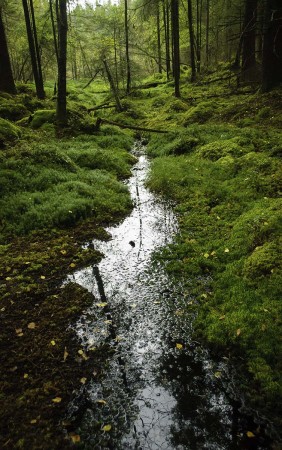Verles old-growth forest
Saved from logging
Verles old-growth forest is a forest area of about 80 ha in Ale Municipality (about 5 km NE of Gothenburg) with very high nature values. Without Naturarvet's negotiations with the landowner, the forest would have been felled already in winter 2007/2008. Neither the Swedish Forest Agency nor the County Administrative Board had the funds to protect the forest that had been notified for logging. Naturarvet had until 19 March 2009 to raise enough money to save Verles old-growth forest from logging. The deadline was approaching and there was still a large amount of money left to save the forest. The municipality contributed about 2 million SEK, the West Coast Foundation about 2 million SEK and together with the 2.4 million SEK raised by the Naturarvet, the purchase could be made and the forest was preserved for all time. The field biologists had given 400 000 SEK in contributions to Ale Municipality and the West Coast Foundation (to share) and the Swedish Environmental Protection Agency had contributed about 1.9 million SEK to Ale Municipality and the West Coast Foundation (to share). This is a unique solution for Sweden, where both non-profit forces, a municipality, the region and the state work together to preserve a old-growth forest as a nature reserve.
 Biological conservation values
Biological conservation values
The great value of the area lies in the high age and relative untouchedness of the forest, which creates good living conditions for many coniferous forest species. For example, the area contains many pine trees up to 200 years old. The proportion of dead wood in the form of dry shrubs and flames is good in parts, which benefits many wood-dwelling insects and wood fungi as well as cavity-nesting bird species. The bird fauna is rich, with many species of birds typical of areas of old coniferous forest. Among the tigers, various species of tits, thrushes and woodpeckers are common . The area is also a regular breeding ground for the spotted owl and the eagle owl, as well as the buzzard, osprey and great horned owl. Plover's nestis seen annually with varying numbers of roosters and the area has also been regularly visited by grouse, bee-hawk and cuckoo. The area's poor moraine soils do not support a rich herbaceous flora, but there are some interesting finds in the area, including the spruce tree Pedicularis sylvatica and the orchids knee-rot Goodyera repens and spider flower Listera cordata. The ag Cladium mariscus has also been recorded on the banks of the small Ljusevattnet. Ag is the largest of our half-grasses and can grow over two metres high. Ag is calcareous and rare in southern Sweden, except on Gotland where it is common. In Risveden, the species is probably a relic from a warmer period. The cryptogamic flora is also relatively poor but with some interesting finds such as the glossy spadix Arthonia spadicea, the rusty spadix Arthonia vinosa, the cat's-foot flax Arthonia leucopellaea and the downy moss Trichocolea tomentella.
How to find Verle old-growth forest

By public transport: From Göteborgs C, take the train to Älvängen. From there, take bus 434 towards Getås and get off at Verle Östergård. Walk back along the road in the direction the bus came from for 250 metres. At the sign for "Holmevattnet 3", turn left onto the road. Follow this road for about 3 kilometres. When the road has crossed a bridge, go past the first turn-off to the right, but turn into the second one where it says "Naturreservat". After about 300 metres you will reach the information board for Verleskogen.
By car: Take the E45 north from Gothenburg. At Älvängen, turn off towards Skepplanda. In Skepplanda, when the road bends sharply to the right, turn left towards Hålanda. Follow the road and just after Verle village at the sign for "Holmevattnet 3", turn right on the road. Follow this road for about 3 kilometres. When the road has crossed a bridge, drive past the first turn-off to the right, but turn onto the second one where it says "Naturreservat". After about 300 metres you will come to the information board for Verleskogen. You can park your car there. If you are coming from the east along the Kvarnabo road, there is also a sign for Verle nature reserve via a gravel road for about 10 km.
In the forest there is a path that goes in a loop around the reserve. It is marked with blue markings